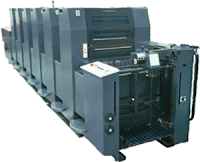-with inventing the technology of printing with moveable type.
Post a photo of the Gutenberg Press.

How did the printing press work?
-hand press-ink was rolled over the raised surface of movable hand set block letter held within a wooden form, then form was pressed against a sheet of paper.
What motivated Gutenberg to find a better way of creating books?
-his love of reading motivated him to find a better way to create books.
Why did Gutenberg experiment with metal type versus wood type?
-woodcuts were not durable
Post an example of movable type in a type case.

What is moveable type?
-movable type is the system of printing that uses movable components to reproduce the elements of a document.
What is a matrix?
-can be reused so the same character appearing anywhere within the book will appear very uniform.
What ink did Gutenberg develop that he used specifically for the printing press?
-oil based ink was more durable than water based ink and it was oily varnish-like ink made out of soot, turpentine, and walnut oil.
What is paper made from? Where did paper originate?
-paper was made from wood pulp and originated in China.
What is a "substrate"?
-Paper
Who did Gutenberg seek to help with the invention of the press? Close to the end of the 5 years, what happened?
-John Fust a wealthy business man, to invest after 5 years Fust would get the press, tools, and materials.
What was the first book he printed?
-The Bible
Post an example of this book.

How did the Gutenberg Press impact communication?
-People could send letters and communicate during wars because now paper was cheap .
Who introduced the printing press to England?
-Milliam Caxton
What was the early form of newspapers?
-trade newsletters
When was the first news weekly published? What was it called?
-The Boston Letter, the First American weekly.
What kind of press was built in the US in the mid 1800s?
-press made out of cast iron.
Post an example of a 1930s printing press.

By the late 1930s, presses had increased in efficiency and were capable of 2,500 to 3,500 impressions per hour. What is meant by "impression"?
-the letters
Which printing process is the Gutenberg press an example of? Briefly describe the process?
-the typewrite the letters that you type are inked and when you type the letter press down on a piece of paper and when your done you take the paper out.
Post an example of an intaglio press.
What is intaglio printing and how is ink transferred?
-image area is etched into the plate surface to hold the ink, the ink is applied, then rubbed with a cloth to remove the excess then damp paper is placed on top and a press applies pressure to transfer the ink into the paper.
Post an example of a screen (porous) printing press.
What is porous printing and how is ink transferred?
-was a basic stencil process in which the image carrier is attached to a screen then the ink is forced through open mesh areas.
Post an example of a lithography printing press.
What is lithography and how is ink transferred?
-is printing from a flat surface, based on the concept that oil and water do not readily mix.
Post an example of a offset lithography printing press.
What variation of lithography is used by the commercial printing industry today?
-most commercial printing is printed with a similar form of the lithography process called offset lithography.
How do printing presses used today compare to the Gutenberg Press?
-for newspapers we still use ink based printing.
Describe four-color process printing using CMYK?
-cyan, magenta, yellow, and black


















